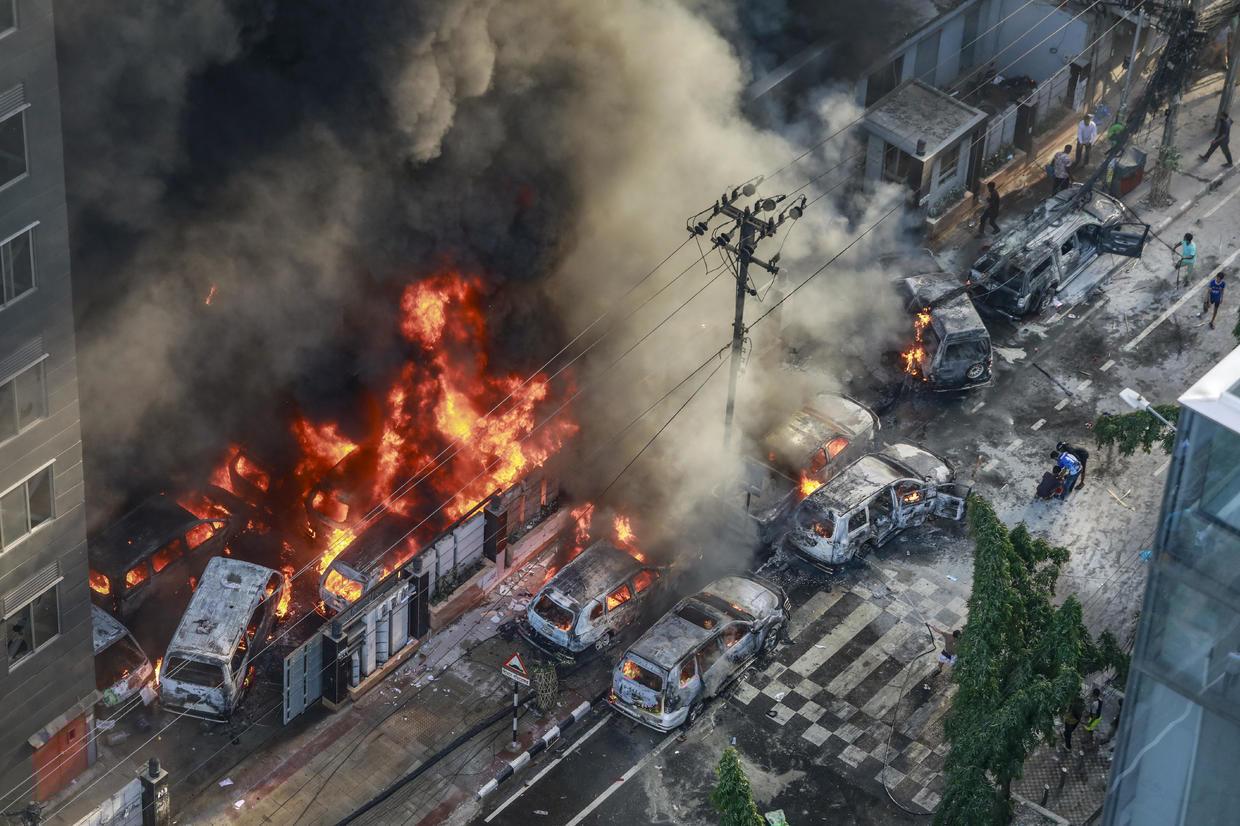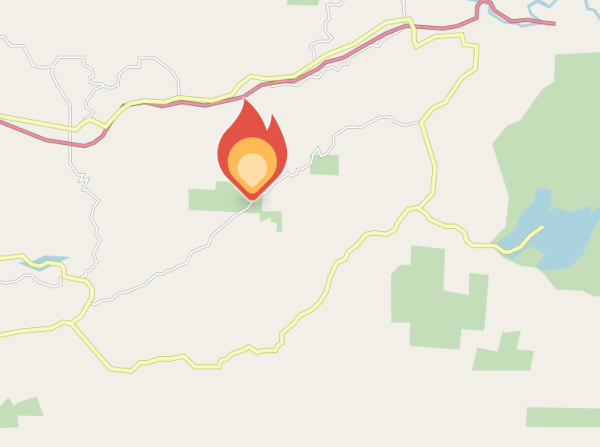
As I am writing this statement, I don’t know the whereabouts of most of my comrades who participated in the ongoing protest of students in Bangladesh. All I know is that they were on the streets, trying to fight back against the police, against the fascist goons of the autocratic party. As only people from some parts of Bangladesh have regained internet access after five days of state ordered nationwide internet blackout, connecting to people back home from abroad has been tough. As new photos and news unveil the unprecedented violence of the police, where they are torturing and killing unarmed people, I go through feelings of anguish and anger. I think about my comrades back in the country, but it’s not only about them, it’s about the entire country. I only know that my comrades are part of the resistance where thousands of others joined, where people are protesting against the fascist and autocratic state, which has killed at least 197 people, detained hundreds, and left thousands injured in the hospitals.
All of this started with a peaceful protest by the students and government job seekers in demand for quota reformation. The quota system in Bangladesh reserves 30% of the jobs for the descendants of the freedom fighters who took part in the liberation war against Pakistan in 1971. This 30% quota leaves most general people with very little chance to secure a government job. The problem of unemployment and recent economic crises have made government jobs very competitive, and most people consider this 30% quota discriminatory and unfair. Even though the ruling party describes the quota system as a way to show respect to the family of freedom fighters, in reality, the ruling party used it to have an obedient group of people in bureaucracy. First of all, the liberation war of Bangladesh in 1971 against Pakistan was a people’s war; people from all walks of life helped the freedom fighters through various means. Second, many of the poor freedom fighters belonging to the working class couldn’t manage any certificate of being freedom fighters. Third, there have been claims of corruption and nepotism in issuing freedom fighter certificates by the ruling party. So, this 30% quota allows the government to consolidate their power. Furthermore, reserving 30% of government jobs for the third generation of freedom fighters, which is less than 5% of the population, stands against the central ethos of the liberation war: equality, freedom, and justice. As anarchists, we supported the just demand of the students. Still, we also believed that mere quota reformation could not solve the problem of the capitalist economy maintained by an autocratic ruling party. However, things escalated when the government responded to the peaceful protest with unparalleled violence from police and their fascist goons. The state violence against protesters completely transformed the current movement. Before moving to this part of the current stage of the movement, it’s necessary to describe the current political scenario of Bangladesh.
For the past 16 years, Bangladesh has been ruled by Prime Minister Sheikha Hasina and her party, Awami League. Even though they first came to power by gaining an electoral majority, they soon became an autocratic party and retained state power through three rigged or staged general elections. Furthermore, Sheikh Hasina and her party boast of being the only party in favor of the spirit of liberation war. In reality, they have appropriated the spirit and gains of liberation war from the masses. They have tried to portray the liberation war from only a nationalistic perspective while it was a peoples’ war led by aspiration for equality, freedom and justice. Post-independence, the class characteristics of the state did not transform, as one group of domestic rulers just replaced another group of foreign rulers. The state apparatus and legal systems also continued to carry the legacy of the Pakistani and British colonial ruling system. Awami league in their last 16 years of rule has utilized all of these organs of the state ruling system to wipe out opposing views. They have justified it by using their nationalistic rhetoric and tagging everyone else as anti-liberation force.
Even though Bangladesh has achieved high GDP growth in the past decade, it mainly came through the expense of cheap labor in readymade garment sectors and exporting of low skilled labor in middle east. Both of these groups have suffered from inhumane working conditions. While the collapse of Rana Plaza, which killed 1134 people in 2013, managed to gain coverage in international media, other killings from fire and police crackdown have gone unnoticed. The government has cracked down on many labor unions (including the abduction of a union leader), took control of most of the other labor unions, and banned union activity in some areas. Even in the last year, garment workers were killed and arrested for demanding an increase in minimum age. Recently, Bangladesh’s economy has been facing a crisis as its short-term development strategy financed by borrowing money is having repercussions. Imperialist and expansionist powers such as the United States, China, and India consider Bangladesh to be a geopolitical region of interest. India, the country that shares borders with Bangladesh, has been most influential in the politics of Bangladesh as they offer the government “legitimacy” to the West in exchange for contracts that only satisfy the interest of the Indian government. Although the ruling party has managed to be reelected for another term without a fair or inclusive election, people are suffering from unemployment, inflation, inequality, and oppression by the ruling party.
The current economic condition and lack of fundamental human rights have created mass discontent among the people of Bangladesh, especially the youth. However, the government, ruled by Hasina, after the recent re-election, considered it to be virtually unchallenged in continuing its regime of corruption and exploitation. So, when the students started peaceful protests for a fair quota system that would prioritize merit, the ruling party resorted to violence. First, they employed the students league, the fascist foot soldiers of the ruling fascist party. They mercilessly beat students and protesters and even attacked them in hospitals. However, this time, the students soon created resistance and managed to regain control of the dormitories from this fascist student wing for the first time in 16 years of Awami rule. Then, the government called the police force to stop the protest. The police used brutal measure and started killing protesters on July 16. That failed to stop the resistance, and it only grew in numbers. The coordinators of the movement called for a complete shutdown of all public activities in the following days.
On July 18, the police and ruling party goons used unforeseen levels of violence as they attacked students protesting inside and in front of universities and high schools. However, the students showed immense courage and tried to fight back. They organized themselves, coordinated with each other and used their limited resources to hit back against the state violence. In different areas, the foot soldiers of the regime and the police force were compelled to leave the area as the protesters fought back. The government also multiplied violence in response and went on a killing spree. By the afternoon of July 18, confirmed news of the killing of many University and high school students were circulated on social media. Mass people started joining the movement, and violent clashes took place between them and armed forces (and ruling party goons). Later that day, the government completely blocked internet access to the entire country to quell the protest. That did not succeed, and protesters continued the resistance the next day, July 19.
Different political party members also joined the movement at this point, but the participation of the mass people and students continued. The armed forces shot and killed at least 70 protesters that day. Most of the people killed were students, but photographer, rickshaw puller, and transportations workers were also killed. 2 policemen were also killed by the protesters during the clash. From Friday night, the government enacted a curfew and employed the military. However, clashes and death were also reported on Saturday.
As only some of Bangladesh regained internet access after 5 days of internet blackout from government, it’s difficult to obtain reliable news. The media operating within the country is heavily controlled by the government. The government is also not providing any information on the number of deaths, nor is it allowing medical officials to do so. There have been claims of police seizing death registers from hospitals. According to one leading newspaper in Bangladesh, at least 197 people have been killed in the ongoing protest. However, the actual number is estimated to be way higher. People and news reporters state that they haven’t witnessed such a massive scale of violence in years. Photos and videos are emerging where we can see piles of dead bodies lying on the floor of a hospital, the police continuously shooting at unarmed people from point-blank range. As reported by DW news, UN vehicles for peacekeeping missions have also been used by the armed forces to attack protesters in Bangladesh.
Aside from resistance on the ground, the youth are rejecting and tearing down every narrative of the fascistic party and the authoritarian state. The mass people of Bangladesh have shown immense solidarity with the student movement as they view it as a rightful resistance against the autocratic leader Sheikh Hasina. Local people provided free food and shelter and helped the injured people to reach hospitals. People have expressed mass disobedience and non-cooperation with the state during the movement. The working-class people have shown incredible solidarity with the students in the protest. They have actively supported them and, in some areas, participated with the students. During the movement, the students used various tactics of direct action and mutual aid that helped them to resist successfully.
On July 21, the supreme court gave a verdict in favor of quota reform. Even though the suggested distribution reduces the quota for freedom fighters’ descendants which the protesters demanded, it also reduces the quota for disadvantaged groups of citizens, which is unfair. Furthermore, after the mass killings in the past week, the situation has gone well past quota reformation, and a large number of people now demand the resignation of the Prime minister Sheikh Hasina. However, through controlling media, communication, and excessive force, the government has retained some ground. The police have detained hundreds of students. One of the coordinators was also abducted and tortured by the armed forces. The government is trying to portray that things are getting normal, and soon they will probably have to resume internet connection in the entire country and bring an end to the curfew as businesses are going through heavy losses due to shut down. When the internet gets back, the coordinators and protesters will have to face a tough battle against an unmasked dictatorship that has blood of hundreds of people in its hand.
I don’t think that Bangladesh can go back to being normal again after this killing spree and violence of the ruling party. The people of Bangladesh must decide if totalitarianism by a fascist party will be the fate of the country or will people regain their power. The movement, which started as a protest for fair opportunity in jobs, has transformed into a mass uprising against fascist Hasina’s rule and state violence where the people of Bangladesh are expressing their urge to live with freedom, rights, and dignity. However, to reach that destiny, we need a democratic transformation of the state, we need to dismantle elite armed force which commits extrajudicial killing, and we need to restructure every institution so that nobody ever can gain the power to commit such atrocities. We need to throw away neo-liberal policies and move towards an economy for the people and workers, not for the capitalist class. However, for all of this to happen, we need a strong working-class movement and civil rights movement. So far, the people and society have shown incredible resistance against state violence. The resistance marks a new beginning for the struggle towards a more equal, just, and free Bangladesh. The future is uncertain but if this movement shows anything, it has shown that organized people fighting for just cause can show unthinkable resistance. We reject a future of totalitarianism, and we expect nothing less than a people’s revolution.
24 July 2024
The writer is a member of the anarchist group Auraj network About Auraj: Auraj (Auraj means anarchy in Bangla) is an anarchist network of Bangladeshi students and other people from different professions. Auraj has published various translations of Anarchist thinkers such as Bakunin, Kropotkin, Rudolf Rocker, and others in Bangla. Auraj also frequently publishes articles on Bangladesh’s political and economic scenario. Auraj has shown solidarity with the recent labor movements (movements of garment workers, jute mill workers), student movements, and civil rights movements in Bangladesh. Although members of Auraj have individually taken part directly in many of these movements, including the ongoing current resistance, the activity of Auraj as a group is mainly limited to publication.Facebook:
https://www.facebook.com/auraj.banglaWebsite:
https://www.auraj.netAnarchist Federationhttps://abolitionmedia.noblogs.org/post/2024/07/26/peoples-uprising-against-an-autocratic-state-the-present-past-and-future-of-bangladesh/#
anarchist #
asia #
Auraj #
Bangladesh #
students #
uprising

As I am writing this statement, I don’t know the whereabouts of most of my comrades who participated in the ongoing protest of students in Bangladesh. All I know is that they were on the streets, trying to fight back against the police, against the fascist goons of the autocratic party. As only people from some parts of Bangladesh have regained internet access after five days of state ordered nationwide internet blackout, connecting to people back home from abroad has been tough. As new photos and news unveil the unprecedented violence of the police, where they are torturing and killing unarmed people, I go through feelings of anguish and anger. I think about my comrades back in the country, but it’s not only about them, it’s about the entire country. I only know that my comrades are part of the resistance where thousands of others joined, where people are protesting against the fascist and autocratic state, which has killed at least 197 people, detained hundreds, and left thousands injured in the hospitals.
All of this started with a peaceful protest by the students and government job seekers in demand for quota reformation. The quota system in Bangladesh reserves 30% of the jobs for the descendants of the freedom fighters who took part in the liberation war against Pakistan in 1971. This 30% quota leaves most general people with very little chance to secure a government job. The problem of unemployment and recent economic crises have made government jobs very competitive, and most people consider this 30% quota discriminatory and unfair. Even though the ruling party describes the quota system as a way to show respect to the family of freedom fighters, in reality, the ruling party used it to have an obedient group of people in bureaucracy. First of all, the liberation war of Bangladesh in 1971 against Pakistan was a people’s war; people from all walks of life helped the freedom fighters through various means. Second, many of the poor freedom fighters belonging to the working class couldn’t manage any certificate of being freedom fighters. Third, there have been claims of corruption and nepotism in issuing freedom fighter certificates by the ruling party. So, this 30% quota allows the government to consolidate their power. Furthermore, reserving 30% of government jobs for the third generation of freedom fighters, which is less than 5% of the population, stands against the central ethos of the liberation war: equality, freedom, and justice. As anarchists, we supported the just demand of the students. Still, we also believed that mere quota reformation could not solve the problem of the capitalist economy maintained by an autocratic ruling party. However, things escalated when the government responded to the peaceful protest with unparalleled violence from police and their fascist goons. The state violence against protesters completely transformed the current movement. Before moving to this part of the current stage of the movement, it’s necessary to describe the current political scenario of Bangladesh.
For the past 16 years, Bangladesh has been ruled by Prime Minister Sheikha Hasina and her party, Awami League. Even though they first came to power by gaining an electoral majority, they soon became an autocratic party and retained state power through three rigged or staged general elections. Furthermore, Sheikh Hasina and her party boast of being the only party in favor of the spirit of liberation war. In reality, they have appropriated the spirit and gains of liberation war from the masses. They have tried to portray the liberation war from only a nationalistic perspective while it was a peoples’ war led by aspiration for equality, freedom and justice. Post-independence, the class characteristics of the state did not transform, as one group of domestic rulers just replaced another group of foreign rulers. The state apparatus and legal systems also continued to carry the legacy of the Pakistani and British colonial ruling system. Awami league in their last 16 years of rule has utilized all of these organs of the state ruling system to wipe out opposing views. They have justified it by using their nationalistic rhetoric and tagging everyone else as anti-liberation force.
Even though Bangladesh has achieved high GDP growth in the past decade, it mainly came through the expense of cheap labor in readymade garment sectors and exporting of low skilled labor in middle east. Both of these groups have suffered from inhumane working conditions. While the collapse of Rana Plaza, which killed 1134 people in 2013, managed to gain coverage in international media, other killings from fire and police crackdown have gone unnoticed. The government has cracked down on many labor unions (including the abduction of a union leader), took control of most of the other labor unions, and banned union activity in some areas. Even in the last year, garment workers were killed and arrested for demanding an increase in minimum age. Recently, Bangladesh’s economy has been facing a crisis as its short-term development strategy financed by borrowing money is having repercussions. Imperialist and expansionist powers such as the United States, China, and India consider Bangladesh to be a geopolitical region of interest. India, the country that shares borders with Bangladesh, has been most influential in the politics of Bangladesh as they offer the government “legitimacy” to the West in exchange for contracts that only satisfy the interest of the Indian government. Although the ruling party has managed to be reelected for another term without a fair or inclusive election, people are suffering from unemployment, inflation, inequality, and oppression by the ruling party.
The current economic condition and lack of fundamental human rights have created mass discontent among the people of Bangladesh, especially the youth. However, the government, ruled by Hasina, after the recent re-election, considered it to be virtually unchallenged in continuing its regime of corruption and exploitation. So, when the students started peaceful protests for a fair quota system that would prioritize merit, the ruling party resorted to violence. First, they employed the students league, the fascist foot soldiers of the ruling fascist party. They mercilessly beat students and protesters and even attacked them in hospitals. However, this time, the students soon created resistance and managed to regain control of the dormitories from this fascist student wing for the first time in 16 years of Awami rule. Then, the government called the police force to stop the protest. The police used brutal measure and started killing protesters on July 16. That failed to stop the resistance, and it only grew in numbers. The coordinators of the movement called for a complete shutdown of all public activities in the following days.
On July 18, the police and ruling party goons used unforeseen levels of violence as they attacked students protesting inside and in front of universities and high schools. However, the students showed immense courage and tried to fight back. They organized themselves, coordinated with each other and used their limited resources to hit back against the state violence. In different areas, the foot soldiers of the regime and the police force were compelled to leave the area as the protesters fought back. The government also multiplied violence in response and went on a killing spree. By the afternoon of July 18, confirmed news of the killing of many University and high school students were circulated on social media. Mass people started joining the movement, and violent clashes took place between them and armed forces (and ruling party goons). Later that day, the government completely blocked internet access to the entire country to quell the protest. That did not succeed, and protesters continued the resistance the next day, July 19.
Different political party members also joined the movement at this point, but the participation of the mass people and students continued. The armed forces shot and killed at least 70 protesters that day. Most of the people killed were students, but photographer, rickshaw puller, and transportations workers were also killed. 2 policemen were also killed by the protesters during the clash. From Friday night, the government enacted a curfew and employed the military. However, clashes and death were also reported on Saturday.
As only some of Bangladesh regained internet access after 5 days of internet blackout from government, it’s difficult to obtain reliable news. The media operating within the country is heavily controlled by the government. The government is also not providing any information on the number of deaths, nor is it allowing medical officials to do so. There have been claims of police seizing death registers from hospitals. According to one leading newspaper in Bangladesh, at least 197 people have been killed in the ongoing protest. However, the actual number is estimated to be way higher. People and news reporters state that they haven’t witnessed such a massive scale of violence in years. Photos and videos are emerging where we can see piles of dead bodies lying on the floor of a hospital, the police continuously shooting at unarmed people from point-blank range. As reported by DW news, UN vehicles for peacekeeping missions have also been used by the armed forces to attack protesters in Bangladesh.
Aside from resistance on the ground, the youth are rejecting and tearing down every narrative of the fascistic party and the authoritarian state. The mass people of Bangladesh have shown immense solidarity with the student movement as they view it as a rightful resistance against the autocratic leader Sheikh Hasina. Local people provided free food and shelter and helped the injured people to reach hospitals. People have expressed mass disobedience and non-cooperation with the state during the movement. The working-class people have shown incredible solidarity with the students in the protest. They have actively supported them and, in some areas, participated with the students. During the movement, the students used various tactics of direct action and mutual aid that helped them to resist successfully.
On July 21, the supreme court gave a verdict in favor of quota reform. Even though the suggested distribution reduces the quota for freedom fighters’ descendants which the protesters demanded, it also reduces the quota for disadvantaged groups of citizens, which is unfair. Furthermore, after the mass killings in the past week, the situation has gone well past quota reformation, and a large number of people now demand the resignation of the Prime minister Sheikh Hasina. However, through controlling media, communication, and excessive force, the government has retained some ground. The police have detained hundreds of students. One of the coordinators was also abducted and tortured by the armed forces. The government is trying to portray that things are getting normal, and soon they will probably have to resume internet connection in the entire country and bring an end to the curfew as businesses are going through heavy losses due to shut down. When the internet gets back, the coordinators and protesters will have to face a tough battle against an unmasked dictatorship that has blood of hundreds of people in its hand.
I don’t think that Bangladesh can go back to being normal again after this killing spree and violence of the ruling party. The people of Bangladesh must decide if totalitarianism by a fascist party will be the fate of the country or will people regain their power. The movement, which started as a protest for fair opportunity in jobs, has transformed into a mass uprising against fascist Hasina’s rule and state violence where the people of Bangladesh are expressing their urge to live with freedom, rights, and dignity. However, to reach that destiny, we need a democratic transformation of the state, we need to dismantle elite armed force which commits extrajudicial killing, and we need to restructure every institution so that nobody ever can gain the power to commit such atrocities. We need to throw away neo-liberal policies and move towards an economy for the people and workers, not for the capitalist class. However, for all of this to happen, we need a strong working-class movement and civil rights movement. So far, the people and society have shown incredible resistance against state violence. The resistance marks a new beginning for the struggle towards a more equal, just, and free Bangladesh. The future is uncertain but if this movement shows anything, it has shown that organized people fighting for just cause can show unthinkable resistance. We reject a future of totalitarianism, and we expect nothing less than a people’s revolution.
24 July 2024
The writer is a member of the anarchist group Auraj network
About Auraj: Auraj (Auraj means anarchy in Bangla) is an anarchist network of Bangladeshi students and other people from different professions. Auraj has published various translations of Anarchist thinkers such as Bakunin, Kropotkin, Rudolf Rocker, and others in Bangla. Auraj also frequently publishes articles on Bangladesh’s political and economic scenario. Auraj has shown solidarity with the recent labor movements (movements of garment workers, jute mill workers), student movements, and civil rights movements in Bangladesh. Although members of Auraj have individually taken part directly in many of these movements, including the ongoing current resistance, the activity of Auraj as a group is mainly limited to publication.
Facebook: https://www.facebook.com/auraj.bangla
Website: https://www.auraj.net
Anarchist Federation
https://abolitionmedia.noblogs.org/post/2024/07/26/peoples-uprising-against-an-autocratic-state-the-present-past-and-future-of-bangladesh/
#anarchist #asia #Auraj #Bangladesh #students #uprising
People’s uprising against an autocratic state: The present, past and future of Bangladesh As I am writing this statement, I don’t know the whereabouts of most of my comrades who participated in the ongoing protest of students in Bangladesh. All
Ideas And Action (Anarchist Federation)






